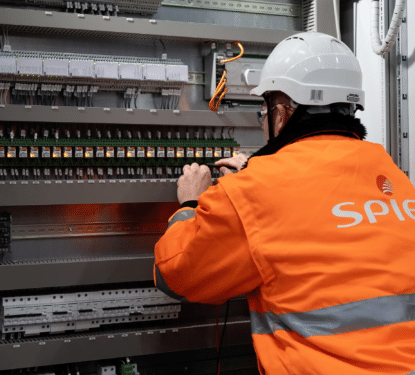“It has always been clear that LiFi is a disruptive technology, but for that to happen it will take some time. There are already many people, worldwide, that have recognised the opportunities of this technology and it is all going in the right direction. I predict that we will see this technology introduced to the market in three to five years, on a large scale,” Professor Harald Haas, the man who coined the term “LiFi” told Memoori in an interview in 2015.
Five years down the line and LiFi may not be a household name but we are starting to see some light at the end of the tunnel for this potentially disruptive technology. Innovative pilot projects, long-awaited standards, device-maker recognition, and a range of new technologies are gradually overcoming the barriers that have held up the emergence of LiFi communications.
LiFi is a wireless protocol that utilizes the visible light spectrum to provide wireless networking access. A LiFi transmitter uses LED lights to modulate light intensity – faster than our eyes can perceive – and that is read as data by a photosensitive receiver. Considering LEDs already use a chip to control their output they can modulate up to millions of times per second, theoretically allowing them to transmit data up to 100 times faster than Wi-Fi.
The speeds achieved so far have not disappointed. SLD Laser, a California-based company co-founded by the Nobel-winning co-inventor of the blue LED, Shuji Nakamura, showed off its 20 Gbit/s laser-based Li-Fi at CES consumer electronics show in Las Vegas this month. The 20 Gbit/s speed claimed by SLD is 20 times faster than the fastest LED-based Li-Fi, that of Professor Haas’ Edinburgh-based firm, pureLiFi, and approximately 140 times faster than Signify’s Trulifi system. Despite the greater commercial availability of LEDs, SLD believes that laser-based light offers many advantages.
“The white light sources can be collimated for long-range mobility applications or configured for floodlight broadcast to address large areas,” the company said. “The sources deliver a unique combination of ultra-high data rate and long-range broadcast to address the intense data transfer needs of emerging mobility applications such as smart cars and smart cities.”
While laser-based LiFi is promising to seize specific niche markets, LED-based LiFi is pushing for mass-market domination. Also exhibiting at CES was Li-Fi vendor Oledcomm whose new software, in combination with their ceiling-mounted transmitter, allows users to move from one transmitter to another without losing their Li-Fi connection. Each PoE-enabled “access point” can serve 16 users over 12m2, while the cloud or locally hosted controller software can tie together 10 different access points around a building or campus.
“LiFiMax is the result of more than 10 years of research. We have worked to create a product based on the new communication standards and offer companies unprecedented security and speed in wireless internet,” said Benjamin Azoulay, Oledcomm’s president. “It is a full software IT network management solution that allows the handover/roaming between access points and enables cybersecurity.”
Late last year, Air France tested the very first flight equipped with LiFi technology, developed by Oledcomm and Latécoère on board the commercial flight AF6114 operated by Airbus A321 from Paris-Orly to Toulouse. 12 seats on the flight were enabled with LiFi for the final of a connected gaming tournament for the all-public video game Trackmania² Stadium. The gamers enjoyed a stable multimedia data exchange at a very high speed and very low latency, while the aircraft enjoyed a reduction in weight, and therefore its fuel consumption, due to replacing copper cables with fibre optic technology.
“We are very proud to be the first airline to launch a Li-Fi equipped aircraft and to organize an in-flight video game competition. I am convinced that this experience will pave the way for new in-flight entertainment experiences for our customers, especially with regards to gaming,” said Antoine Laborde, Air France's Innovation Manager. “This first flight equipped with our Li-Fi technology is an important step in the roll-out of this technology in the aeronautical market. We are convinced that Li-Fi will revolutionize in-flight connectivity within the next 5 years,” added Yannick Assouad, CEO of Latécoère.

LED lighting is already ubiquitous in buildings, cities, and transport systems. The major issue now facing the mainstream emergence of LiFi has been the lack of embedded receivers in popular devices. To address this, pureLiFi launched components for integration into mobile devices last year in their effort to create “LiFi for every device and every light”. The company has partnered with Getac, a manufacturer of rugged tablets and PCs for military, manufacturing and automotive industries, to evaluate LiFi for design into their future wireless devices.
“Getac’s partnership with pureLiFi will make us the pioneer in the rugged devices industry to tap on the potential of next-generation connectivity, strengthening our commitment to customers operating in extreme and challenging environments,” said Amanda Ward, Director of EMEA Products and Solutions, Getac. “We look forward to leveraging on this highly innovative technology to provide customers with secure and reliable products that will further enhance productivity and safety in the workplace.”
The other major barrier is the long-awaited development of a global LiFi standard, which is well underway with the help of pureLiFi, the IEEE, and others. The 802.11bb Task Force who will develop and ratify the global standard for LiFi that hopes to integrate LiFi into “every device and every light”. Proponents of the technology expect it to find its place alongside other wireless communications, like WiFi and Bluetooth, each being applied to the problems that best suit their solution. For LiFi, that appears to be the common scenario where data transfer is needed and light exists, but for that to come about the technology first requires embedded receivers and a functional standard.
“LiFi is fully networked bi-directional communication using lighting infrastructure in buildings and public spaces. I’m working on developing the taxonomy of light communication,” pureLiFi co-founder, Harald Haas, told Memoori. “The development of the technology has surpassed even our own expectations. There is now a LiFi association and standards are being developed. Everything is on track.”
Follow to get the Latest News & Analysis about Smart Buildings in your Inbox!



